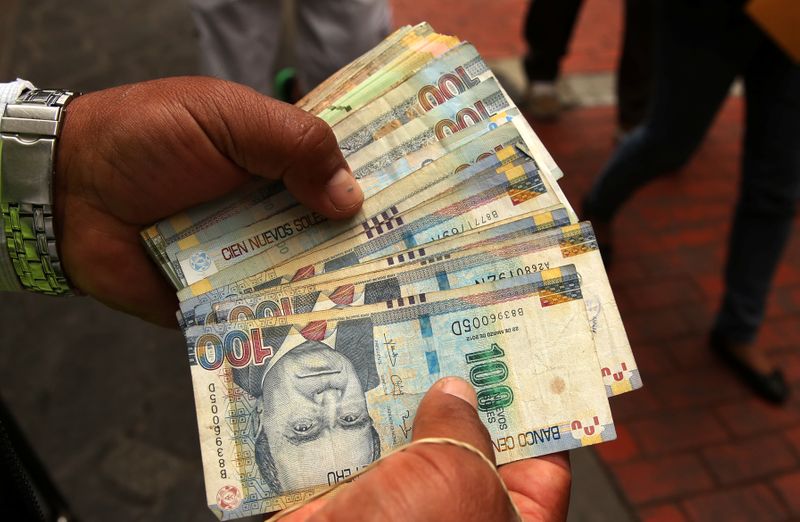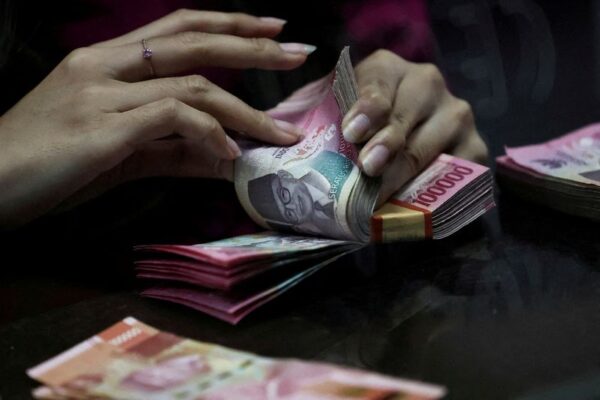Peru currency hits record low, bonds fall on finance ministry vacuum
2/2 © Reuters. FILE PHOTO: A money changer holds Peruvian Sol bills at a street in downtown Lima, Peru, December 15, 2017. REUTERS/Mariana Bazo 2/2 By Rodrigo Campos, Tom Arnold and Marc Jones
NEW YORK (Reuters) -Peru’s currency tumbled to a record low on its largest daily decline in over seven years after new President Pedro Castillo appointed a member of his Marxist party as prime minister and did not yet name a finance minister, leaving the direction of policy and the economy uncertain.
The appointment of Guido Bellido as premier dimmed investor hopes for a moderate administration and sent bond prices lower, with spreads to safe-haven U.S. Treasuries at their widest in over a year.
The 2060 bond issue was down 2 cents on the dollar to trade at 88.3 cents, the 2032 bond fell 1 cent and its century bond was down 2.8 cents, Refinitiv data showed.
The local stock index dropped almost 6% at its session low and posted its lowest close since November. On Wall Street, stocks of Peru based financials Credicorp (NYSE:BAP) and Intercorp Financial Services (NYSE:IFS) fell 16.3% and 10.1% respectively, while miner Buenaventura dropped 5.6%.
The local sol currency lost 3.6% to the greenback to set a record closing low of 4.068 per U.S. dollar.
The decline was the largest for any day in over seven years despite $293 million sold by the central bank to protect the sol.
Peru’s currency is “likely to stay under pressure as the political process plays out,” said Citi analysts in a note. “We expect the central bank to intervene to smooth volatility.”
Bellido’s appointment on Thursday indicated the influence that the far-left Free Peru party may have in Castillo’s administration, set to last until 2026.
“It’s probably too early to make conclusions, but the opening gambit isn’t a positive one,” said Sailesh Lad at Axa Investment Managers.
“We think there is going to be volatility, but I don’t think panic has set in and we are at the stage where (investors) need to exit the country,” Lad said. “At the same time, we haven’t reached the stage where we see opportunities.”
Spreads of Peru’s hard currency bonds over safe-haven U.S. Treasuries on the JPMorgan (NYSE:JPM) EMBI Global Diversified index have risen nearly 30 basis points in the last week to 200 bps – the widest gap since May 2020.
Castillo’s failure to appoint a finance minister exacerbated investor concerns, JPMorgan said in a note.
“The extremely atypical political situation reinforces our call for a persistent scenario characterized by political, institutional, and economic uncertainty,” the bank’s Diego W. Pereira wrote.
The cost of insurance against a default in Peru’s dollar debt rose to its highest in over a year, breaching 102 basis points from 84 earlier this week.
Castillo swore in most of his cabinet on Thursday evening, but the favorite for the finance job, moderate leftist economist Pedro Francke, left the venue shortly before the ceremony started, raising questions over whether he had rejected or lost the job at the last minute.
Castillo, who faces a balancing act between maintaining the faith of investors and improving life for the largely rural base that voted for him, has said he wants to raise taxes on mining companies to fund health and education reforms.
“A possible constitutional change – and therefore its final outcome – is likely to hamper long-term investment as firms should remain cautious,” said Andre Loes, economist at Morgan Stanley (NYSE:MS).
“What is left to support growth is the external backdrop, which should remain solid, except for copper, Peru’s main export item, whose prices are likely to drop due to lower demand.”
Peru is the world’s second-largest copper producer. Its 2022 fiscal deficit targets are likely to be revised higher, with about $4 billion of external bond issuance expected in the second half of 2021, Sebastian Vargas at Barclays (LON:BARC) wrote in a note.












 Bitcoin
Bitcoin  Ethereum
Ethereum  Tether
Tether  XRP
XRP  Solana
Solana  USDC
USDC  Lido Staked Ether
Lido Staked Ether  TRON
TRON  Dogecoin
Dogecoin